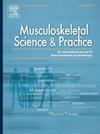识别不同的肩胛骨向上旋转模式的个体与上斜方肌相关的颈部疼痛使用无监督聚类方法
IF 2.2
3区 医学
Q1 REHABILITATION
引用次数: 0
摘要
背景先前关于上斜方肌(UT)相关颈部疼痛的肩胛骨运动的研究结果不一致,二元疼痛分类可能忽略了重要的运动特征。目的采用无监督聚类方法识别ut相关颈痛患者肩胛骨明显向上旋转的模式,并将结果亚组与健康对照进行比较。探索性、横断面设计。方法89例ut相关颈痛患者和25例无症状对照者进行单侧和双侧肩胛骨向上旋转。智能手机摄像头记录了肩峰过程中的标记轨迹。标记沿着x轴和y轴的位移以及y/x比率作为输入特征。采用k -均值聚类,评估组间差异。结果/发现集群1显示受限的位移和升高的y/x比值;簇2显示过度位移,y/x比值正常。控制值在组间存在,疼痛强度不因组而异。结论基于智能手机的聚类揭示了低活动和高活动的肩胛骨表型,支持个性化评估。这种分类可能有助于临床医生评估肩胛骨运动过度和受限如何导致UT相关的颈部疼痛。未来的研究应该在更大的样本中验证这些聚类,并纳入三维运动学。本文章由计算机程序翻译,如有差异,请以英文原文为准。
Identifying distinct scapular upward rotation patterns in individuals with upper trapezius–associated neck pain using unsupervised clustering approach
Background
Previous findings on scapular motion in upper trapezius (UT)-associated neck pain are inconsistent, and binary pain classification may overlook important movement characteristics.
Objectives
To identify distinct scapular upward rotation patterns in individuals with UT-associated neck pain using unsupervised clustering and to compare the resulting subgroups with healthy controls.
Design
Exploratory, cross-sectional design.
Method
Eighty-nine participants with UT-associated neck pain and 25 asymptomatic controls performed unilateral and bilateral scapular upward rotation. A smartphone camera recorded marker trajectories on the acromion process. Marker displacements along the x- and y-axes and the y/x ratio served as input features. K-means clustering was applied, and group differences were assessed.
Results/Findings
Cluster 1 showed restricted displacement and elevated y/x ratios; Cluster 2 displayed excessive displacement with normal y/x ratios. Control values lay between clusters, and pain intensity did not differ by cluster.
Conclusions
Smartphone-based clustering reveals hypomobile and hypermobile scapular phenotypes, supporting personalized assessment. This classification could potentially help clinicians who seek to assess how both excessive and restricted scapular motions may contribute to UT‐associated neck pain. Future studies should validate these clusters in larger samples and incorporate three-dimensional kinematics.
求助全文
通过发布文献求助,成功后即可免费获取论文全文。
去求助
来源期刊

Musculoskeletal Science and Practice
Health Professions-Physical Therapy, Sports Therapy and Rehabilitation
CiteScore
4.10
自引率
8.70%
发文量
152
审稿时长
48 days
期刊介绍:
Musculoskeletal Science & Practice, international journal of musculoskeletal physiotherapy, is a peer-reviewed international journal (previously Manual Therapy), publishing high quality original research, review and Masterclass articles that contribute to improving the clinical understanding of appropriate care processes for musculoskeletal disorders. The journal publishes articles that influence or add to the body of evidence on diagnostic and therapeutic processes, patient centered care, guidelines for musculoskeletal therapeutics and theoretical models that support developments in assessment, diagnosis, clinical reasoning and interventions.
 求助内容:
求助内容: 应助结果提醒方式:
应助结果提醒方式:


